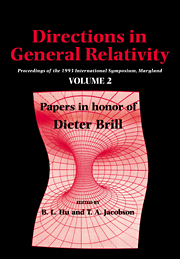 Directions in General Relativity
Directions in General Relativity Published online by Cambridge University Press: 06 January 2010
We resolve the longstanding paradox that in classical electrodynamics the energy and linear momentum of the Abraham-Lorentz (classical) electron do not transform as 4-vector components under Lorentz transformations. In our treatment these quantities transform properly and remain finite in the point particle limit.
Introduction
In Classical Electrodynamics the energy and linear momentum of the extended classical electron do not transform as components of a 4-vector (Leighton, 1959); also infinities arise in the point charge limit.
Abraham (1905) and Lorentz (1909) proposed the classical model of the electron. Lorentz suggested a model in which the electron consisted of a thin, uniformly charged shell. Poincaré (1909) added a stress in order to stabilize the electron. However, he used an expression for the cohesive stress-energy tensor which led to difficulties (Fermi, 1922; Pais, 1948).
Dirac (1938a, 1938b), Matthison (1931, 1940, 1942) and others have proposed point particle models for the classical electron. The lack of covariance associated with the Abraham-Lorentz model and other extended models of the electron does not arise in such models or in classical models based on non local generalisations of Maxwell electromagnetism; see for example, Bopp (1942), McManus (1948) and Feynmann (1948). Erber (1961) reviews much of the literature on models of the classical electron.
To save this book to your Kindle, first ensure [email protected] is added to your Approved Personal Document E-mail List under your Personal Document Settings on the Manage Your Content and Devices page of your Amazon account. Then enter the ‘name’ part of your Kindle email address below. Find out more about saving to your Kindle.
Note you can select to save to either the @free.kindle.com or @kindle.com variations. ‘@free.kindle.com’ emails are free but can only be saved to your device when it is connected to wi-fi. ‘@kindle.com’ emails can be delivered even when you are not connected to wi-fi, but note that service fees apply.
Find out more about the Kindle Personal Document Service.
To save content items to your account, please confirm that you agree to abide by our usage policies. If this is the first time you use this feature, you will be asked to authorise Cambridge Core to connect with your account. Find out more about saving content to Dropbox.
To save content items to your account, please confirm that you agree to abide by our usage policies. If this is the first time you use this feature, you will be asked to authorise Cambridge Core to connect with your account. Find out more about saving content to Google Drive.